Introduction The month on November witnessed the onset of the long awaited short rains and a great relief in the Tsavo ecosystem
Introduction
The month on November witnessed the onset of the long awaited short rains and a great relief in the Tsavo ecosystem. Availability of forage and water in temporary water pans within the park greatly reduced the number of injury cases within the Parks and the adjoining ranches.
Despite the many challenges in the region the unit was able to cope to the challenges encountered in the areas.
1. Rescue of female African hunting dog at Taita hills, 2nd Nov. 2010.
The female wild dog was rescued after allegedly being hit by a vehicle along Mwatate- Taveta road near Taita hills sanctuary. It sustained a dislocation on the left elbow joint which made walking very difficult. 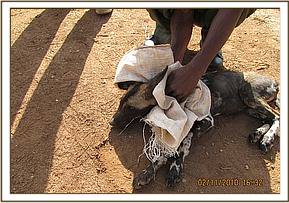

Chemical immobilization and treatment.
Immobilization was done using 100 mgs of Ketamine and 30 mgs Xylazine injected intramuscularly. Antibiotic and multivitamin treatments were administered and loaded to the vet car as there was a giraffe waiting to be desnared nearby.
Conclusion
After stabilization she was taken to Nairobi orphanage for eventual recovery where she is fast recovering.
2. Desnaring of a giraffe at Taita hills sanctuary, 2nd Nov. 2010.
After the rescue of the wild dog, the team headed to the nearby area within Taita hills to desnare a sub adult giraffe which was dragging a wire on the hind limb. The giraffe was easily spotted in an open field looking very nervous probably due to the snaring.
Immobilization and management
Immobilization was done chemically using 10 mgs of etorphine and 30 mgs of Xylazine propelled through CO2 powered dan inject dart. It took approximately 8 minutes for enough drug effects that enabled roping down of the now intoxicated giraffe. With assistance from Taita sanctuary rangers, he was roped down, revived and held on the ground by the neck. 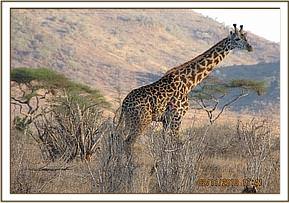
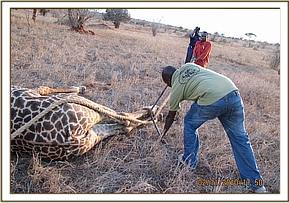
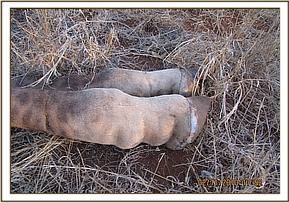

Observation and prognosis
The wire was removed from the right hind leg and despite some small swelling no wound was seen. The limb was given a clean bill of health and the giraffe released.
3. Autopsy report on an elephant calf from Ithumba orphanage 11th Nov. 2010.
Report was made of the death of a young sickly elephant orphan which was earlier rescued from Ziwani area near Tsavo West National Park after being abandoned in a water hole.
Autopsy
The general body condition was poor, rated at about 3 in a scale of up to five. Most internal organs which include gastrointestinal system, cardiac, urinary, nervous, integumentary all seemed normal. Major changes were seen in the lungs where severe bronchial hemorrhages, hepatization of the lungs and exudation of fluids into the lung tissue. 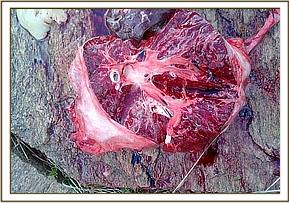
Samples taken
Tissue samples were not taken for bacteriology as the orphan was under strong antibiotic treatment.
Cause of death
Severe bronchopneumonia.
4. Translocation of a problematic lion from Komboyo to Rhino valley in Tsavo west, 12th Nov. 2010.
This young male lion was trapped after allegedly eating an estimated 18 goats in Kuku ranch a community ranch adjacent to Tsavo West National Park. It was brought to Tsavo West Park headquarters for a decision on its fate is made. After a lengthy deliberation, a rescue centre was constructed within the rhino valley where the lion was moved to the rescue centre which is located about 30 kms away. 
Immobilization was done using 300 mgs of etorphine and 300 mgs of Xylazine and loaded to a vehicle for transport. He was finally released, but three days later the team received a sad call from the handler that the lion was found dead in the morning. 
Autopsy carried out revealed severe pneumonia which was not expected as antibiotic cover was given before translocation. Pneumonia was supposedly caused by heavy rains in the rescue centre after the translocation.
5. Desnaring of a water buck within Tsavo East National Park, 15th Nov. 2010.
Lush pastures after the rains especially near the park boundary have seen most grazers and elephants move towards Irima area of the park near Voi town. Local communities are prone to put snares on the hope of snaring some antelopes and waterbucks have borne the brunt of this.
Darting and Desnaring
Darting was done using 6 mgs of etorphine and 60 mgs of Xylazine.
A wire snare was removed from the neck, antibiotic cover and spray was applied appropriately. 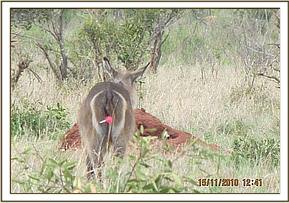


Prognosis is expected to be good.
Conclusion
The unit also rescued a dik dik trapped on a weather station near the research centre and gave it some antibiotic treatments before discharge. 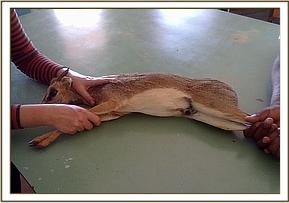
With the rainy season around, the region is expected to remain calm until the next dry season.
The unit wants to thank its sponsors VIER PFOTEN through The David Sheldrick Wildlife Trust for their great support and The Kenya Wildlife Service for the immense assistance too, God bless you all.
Report By: Dr Poghon Jeremiah.
The Mobile Veterinary Unit operated by The David Sheldrick Wildlife Trust working with The Kenya Wildlife Service and funded by Vier Pfoten